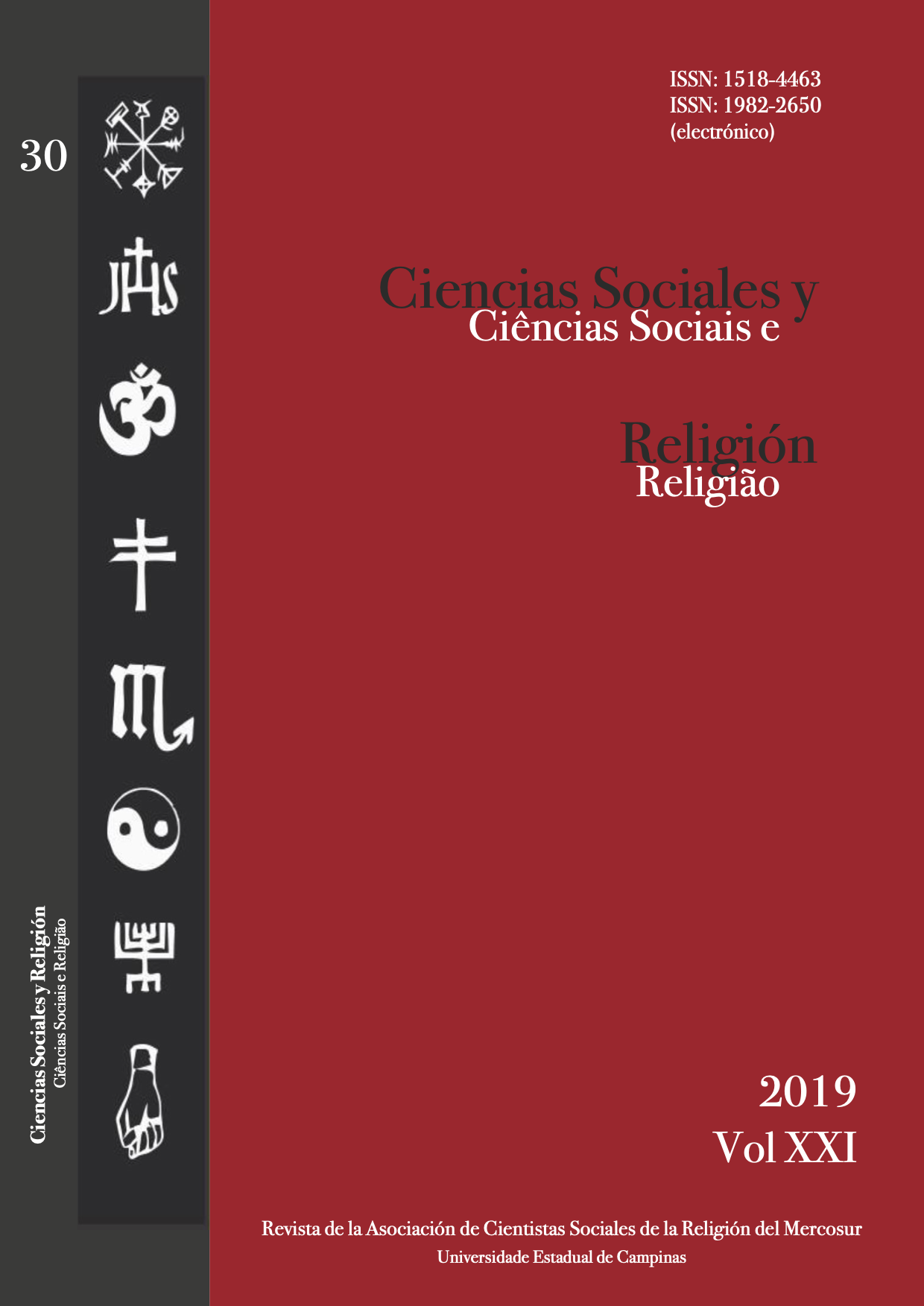Abstract
This article presents some initial reflections related to socialization processes within an educational institution for young women belonging to the Chabad Lubavitch Chassidian religious movement. These reflections revolve around how new practices and representations about femininity are instilled in the context of processes of conversion to orthodox religious frameworks. With that aim we will describe and analyze some educational experiences, which are the subject of ongoing ethnographic research. Our approach to this educational process draws on some perspectives on socialization and morality that appear in Foucault's (1990) studies on the technologies of the self, and mainly the ethnographic works of Mahmood (2011) and Fader (2009). In more general terms, it is part of the literature that explores narratives of modernity in contexts of religious movements and that are structured around gender as an analytical category (Abu Lughod 1999; Brenner 1996; Deeb 2011; Fader 2009; Griffith 1997; Mahmood 2011; Woodhead 2011). Referring to these interpretative frameworks, Benhadjoudja and Milot argue that "the recent research in which gender is used as an analytical tool provided a new approach to religious modernity" (2014: 149). In this sense, we hope to contribute to deepening the understanding of women's adherence to contemporary religious movements, thinking beyond the subordination / subversion binary as the only mode of articulation in which this relationship has been conceptualized (García Somoza and Irrazábal, 2014).
References
ABU-LUGHOD, Lila. Veiled sentiments: Honor and poetry in a Bedouin society. California: University of California Press, 1999.
ASAD, Talad. Genealogies of religion: Discipline and reasons of power in Christianity and Islam. Baltimore & London: JHU Press, 2009.
BENHADJOUDJA, Leila y MILOT, Micheline. Género y secularización: una perspectiva poscolonial. Sociedad y religión, 24 (42), 144-159, 2014.
BERGER, Peter. El dosel sagrado. Elementos para una sociología de la religión. Buenos Aires: Amorrortu, 1971.
BRENNER, Suzanne. Reconstructing self and society: Javanese Muslim women and “the veil”. American Ethnologist, 23 (4), 673-697, 1996.
COSTA, Flavia. El dispositivo fitness en la modernidad biológica. Democracia estética, just-in-time, crímenes de fealdad y contagio. Jornadas de Cuerpo y Cultura, La Plata: FaHCE-UNLP, 2008.
DAVIDMAN, Lynn. Tradition in a rootless world: Women turn to Orthodox Judaism. California: University of California Press, 1991.
DEEB, Lara. An Enchanted Modern: Gender and Public Piety in Shi'i Lebanon: Gender and Public Piety in Shi'i Lebanon. Princeton: Princeton University Press, 2011.
DOUGLAS, Mary. Pureza y peligro. Un análisis de los conceptos de contaminación y tabú. Madrid: Siglo XXI, 1979.
EL-OR, Tamar. “Are They Like Their Grandmothers?” A Paradox of Literacy in the Life of Ultraorthodox Jewish Women, Anthropology & education quarterly, 24 (1), 61-81, 1993.
ERDEI, Ezequiel y JMELNIZKY, Adrián. La población judía de Buenos Aires. Buenos Aires: Editorial AMIA, 2005.
FADER, Ayala. Mitzvah girls: Bringing up the next generation of Hasidic Jews in Brooklyn. Princeton: Princeton University Press, 2009.
FOUCAULT, Michel, MOREY, Miguel y ALLENDESALAZAR, Mercedes. Tecnologías del yo y otros textos afines. Barcelona: Universitat Autònoma de Barcelona, 1990.
FOUCAULT, Michel. Historia de la sexualidad: el uso de los placeres (Vol. 2). México: Siglo XXI, 2002.
GARCÍA SOMOZA, Mari Sol y IRRAZÁBAL, Gabriela. Géneros, sexualidades y religiones: relaciones, intersecciones y confrontaciones. Sociedad y religión, 24 (42), 132-143, 2014.
GEERTZ, Clifford. La interpretación de las culturas, trad. Alberto L. Bixio. 8a reimpresión. Barcelona: Gedisa, 1997.
GOLDMAN CARREL, Barbara. Hasidic women’s Fashion aesthetic and Practice. Modest Fashion: Styling Bodies, Mediating Faith, 91, 2013.
GRIFFITH, R. Marie. God's daughters: Evangelical women and the power of submission. California: Univiversity of California Press, 1997.
HARDING, Susan. The book of Jerry Falwell: Fundamentalist language and politics. Princeton: Princeton University Press, 2001.
HERVIEU-LÉGER, Danièle. Individualism, the validation of faith, and the social nature of religion in modernity. The Blackwell companion to sociology of religion, 161-175, 2003.
JACOBSON, Shari. Modernity, conservative religious movements, and the female subject: Newly ultraorthodox sephardi women in Buenos Aires. American anthropologist, 108 (2), 336-346, 2006.
KAUFMAN, Debra R. Rachel's daughters: Newly orthodox Jewish women. Rutgers University Press, 1991.
MAHMOOD, Saba. Teoría feminista y el agente social dócil: algunas reflexiones sobre el renacimiento islámico en Egipto. In Descolonizando el feminismo: teorías y prácticas desde los márgenes. Barcelona: Cátedra, 2008. pp. 165-222.
MAHMOOD, Saba. Politics of piety: The Islamic revival and the feminist subject. Princeton: Princeton University Press, 2011.
MILLER, Daniel. The Modesty of Clothing and the immodesty of religion. Modest Fashion: Styling Bodies, Mediating Faith, 121, 2013.
PODSERLVER, Lawrence. La téchouva: nouvelle orthodoxie juive et conversion interne. Les Annales, Histoire, Sciences Sociales, EHESS, n°2, mars-avril, pp.275-296, 2002.
SETTON, Damián. “Experiencia identitaria y Reproducción de la autoridad en el judaísmo ortodoxo”. Sociedad y Religión 24 /25, 2002.
SETTON, Damián. La comunidad y el centro de difusión: las dos caras del judaísmo ortodoxo. El caso de Jabad Lubavitch en Argentina. Mitológicas, vol. XXIII, 2008, pp.9-26, 2008.
SETTON, Damián. Instituciones e identidades en los judaísmos contemporáneos. Estudio sociológico en Jabad Lubavitch. Informe de Investigación, N° 2, CEIL-CONICET, 2009.
SETTON, Damián. Judíos ortodoxos y judíos no afiliados en procesos de interacción. El caso de Jabad Lubavitch de la Argentina. Tesis de Doctorado, Facultad de Ciencias Sociales, Universidad de Buenos Aires, 2010.
SETTON, Damián y ALGRANTI, Joaquín. Habitar las instituciones religiosas: corporeidad y espacio en el campo judaico y pentecostal en Buenos Aires. Alteridades, 19 (38), 77-94, 2009.
TOPEL, Martha. Jerusalem y Sao Paulo: A nova ortodoxia judaica em cena, Rio de Janeiro: Topbooks, 2005.
TURNER, Victor. The ritual process: Structure and anti-structure. Ney York: Transaction Publishers, 1995.
WOODHEAD, Linda. Feminism and the sociology of religion: From gender-blindness to gendered difference. In The Blackwell companion to sociology of religion, 2001. pp. 67-84.
YANAY, Niza y RAPOPORT, Tarrara. Ritual impurity and religious discourse on women and nationality. In Women's Studies International Forum, Vol. 20, No. 5, pp. 651-663, Pergamon, 1997.

This work is licensed under a Creative Commons Attribution-NonCommercial-ShareAlike 4.0 International License.
Copyright (c) 2019 Gabriela Grinfeld, Azul Mertnoff
